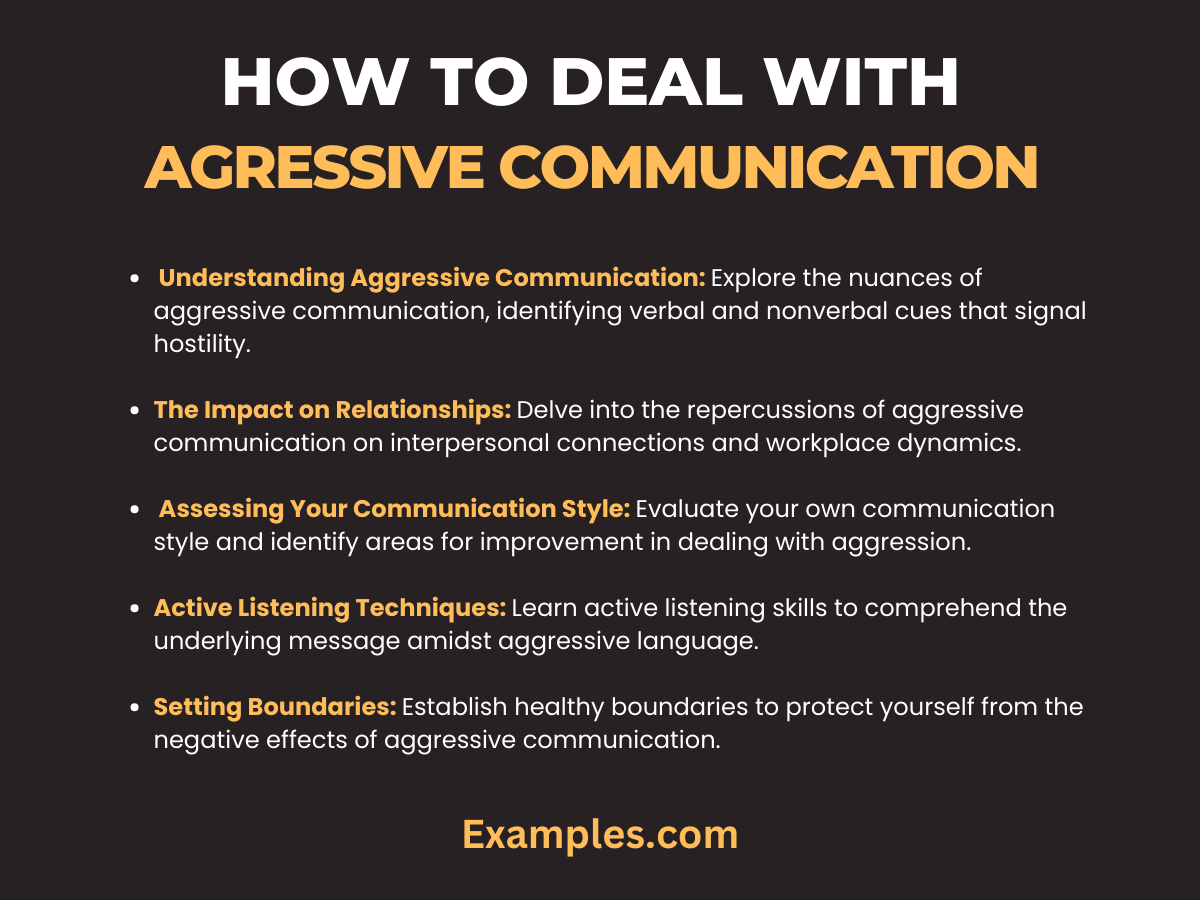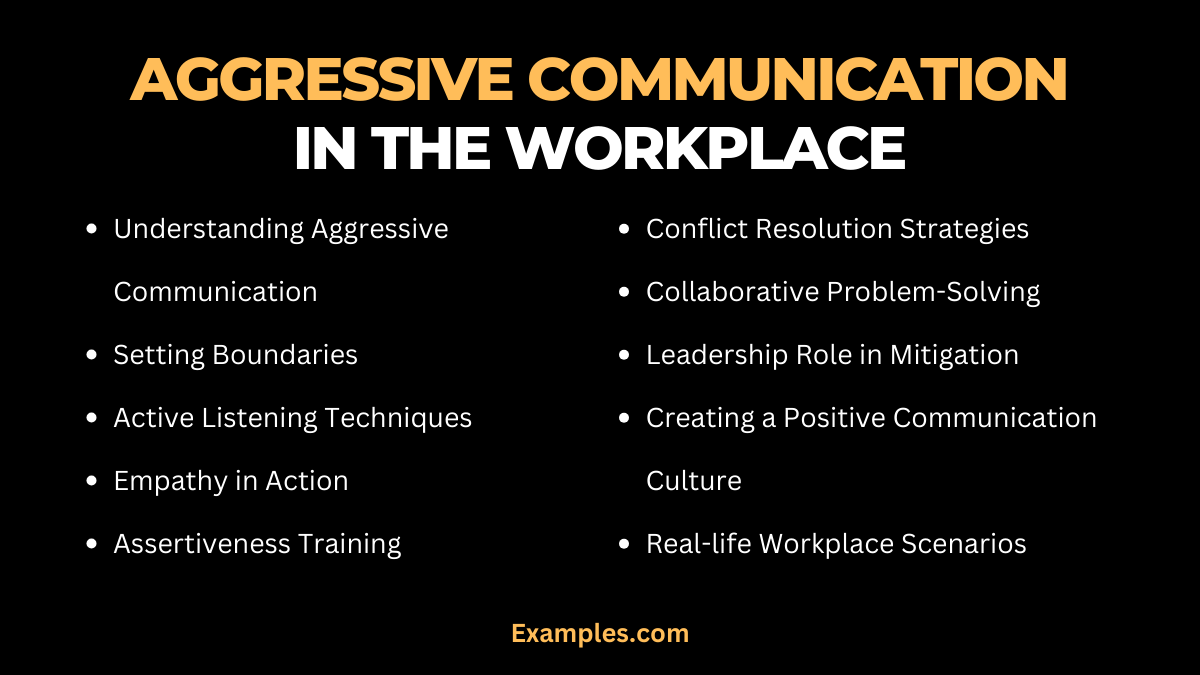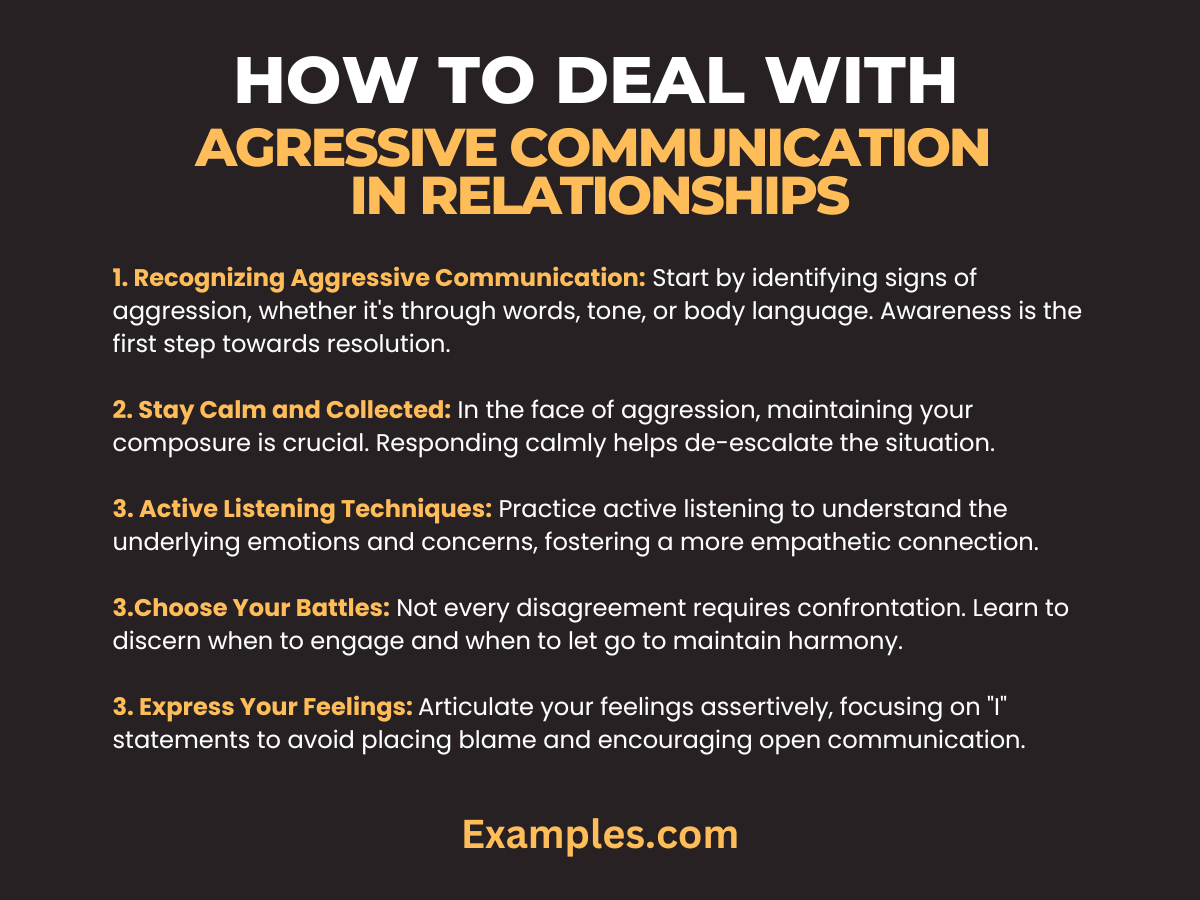How to Deal with Aggressive Communication?
“Dive into our comprehensive guide on How to Deal with Aggressive Communication, a vital skill for navigating challenging interactions. Uncover effective strategies, expert tips, and real-world Communication Examples to diffuse tension and foster healthy dialogue. Elevate your communication skills and transform adversity into opportunities for understanding. Learn to navigate assertively, ensuring smoother relationships in both the workplace and personal connections.”
How to Deal With Aggressive Communication
Aggressive communication can disrupt harmony in relationships and the workplace. This guide provides effective strategies to handle such situations with poise and assertiveness.

- Understanding Aggressive Communication: Explore the nuances of aggressive communication, identifying verbal and nonverbal cues that signal hostility.
- The Impact on Relationships: Delve into the repercussions of aggressive communication on interpersonal connections and workplace dynamics.
- Assessing Your Communication Style: Evaluate your own communication style and identify areas for improvement in dealing with aggression.
- Active Listening Techniques: Learn active listening skills to comprehend the underlying message amidst aggressive language.
- Setting Boundaries: Establish healthy boundaries to protect yourself from the negative effects of aggressive communication.
- Remaining Calm Under Pressure: Develop strategies to stay composed and assertive when faced with aggressive interactions.
- Assertive Communication Tactics: Master the art of assertive communication to express your thoughts and feelings confidently.
- De-escalation Strategies: Acquire practical techniques for de-escalating tense situations and promoting a calmer atmosphere.
- Seeking Professional Help: Explore the option of involving professionals when aggressive communication becomes persistent and harmful.
- Promoting a Positive Communication Culture: Implement proactive measures to foster a positive communication culture, preventing aggression.
How To Deal With Aggressive Communication in the Workplace
Aggressive communication in the workplace can create a challenging environment, impacting both professional relationships and productivity. This comprehensive guide equips you with effective strategies to address and diffuse aggression in various workplace scenarios.

- Understanding Aggressive Communication: Gain insights into the dynamics of aggressive communication. Recognize verbal and nonverbal cues, identifying aggression before it escalates.
- Setting Boundaries: Explore methods for establishing clear and respectful boundaries. Learn how assertive communication can deter aggression and promote a healthier work atmosphere.
- Active Listening Techniques: Master the art of active listening to de-escalate confrontations. Discover how attentive listening fosters understanding and mitigates aggressive behaviours.
- Empathy in Action: Cultivate empathy as a powerful tool to deal with aggressive communication. Understand the underlying emotions, addressing concerns with compassion and sincerity.
- Assertiveness Training: Equip yourself with assertiveness skills to confidently express your thoughts and opinions. Learn how assertive communication can reshape aggressive interactions positively.
- Conflict Resolution Strategies: Explore proven conflict resolution strategies tailored for the workplace. Understand the importance of addressing issues promptly and constructively.
- Collaborative Problem-Solving: Discover collaborative problem-solving techniques to transform conflict into an opportunity for growth. Encourage open dialogue and cooperative solutions.
- Leadership Role in Mitigation: Examine the role of leadership in mitigating aggressive communication. Learn how managers can foster a culture of respect and institute effective communication policies.
- Creating a Positive Communication Culture: Explore proactive measures to create a positive communication culture within your workplace. Foster an environment that values open dialogue and mutual understanding.
- Real-life Workplace Scenarios: Delve into real-life workplace scenarios illustrating the application of strategies discussed. Learn from practical examples to enhance your ability to navigate aggression effectively.
How to Deal With Aggressive Communication in Relationships
Aggressive communication can strain relationships, but understanding and addressing it can pave the way for healthier connections. Here’s a guide on effectively handling aggressive communication within the realm of relationships.

- Recognizing Aggressive Communication: Start by identifying signs of aggression, whether it’s through words, tone, or body language. Awareness is the first step towards resolution.
- Stay Calm and Collected: In the face of aggression, maintaining your composure is crucial. Responding calmly helps de-escalate the situation.
- Active Listening Techniques: Practice active listening to understand the underlying emotions and concerns, fostering a more empathetic connection.
- Choose Your Battles: Not every disagreement requires confrontation. Learn to discern when to engage and when to let go to maintain harmony.
- Express Your Feelings: Articulate your feelings assertively, focusing on “I” statements to avoid placing blame and encouraging open communication.
- Set Boundaries: Clearly define personal boundaries and communicate them assertively. Establishing limits is key to maintaining a healthy relationship.
- Seek Professional Help if Needed: In some cases, involving a therapist or counsellor can provide valuable insights and strategies for managing aggression within the relationship.
- Encourage Open Communication: Foster an environment where both parties feel safe expressing their thoughts and emotions without fear of judgment.
- Collaborate on Solutions: Work together to find constructive solutions that address the root causes of aggression, promoting mutual understanding.
- Practice Empathy: Cultivate empathy towards your partner’s perspective. Understanding each other’s viewpoints lays the foundation for resolution.
- Monitor Nonverbal Cues: Pay attention to nonverbal cues such as body language and facial expressions. These cues often convey emotions that words may not express.
- Reinforce Positive Communication Patterns: Celebrate and reinforce positive communication. Acknowledge moments of healthy expression and encourage their continuation.
In concluding our guide on dealing with aggressive communication, embrace newfound strategies to transform conflict into understanding. By navigating assertively, setting boundaries, and fostering empathy, you empower yourself to defuse tense situations. Real-life examples illuminate the path to healthier relationships. Elevate your communication prowess, turning aggression into opportunities for connection and collaboration.



